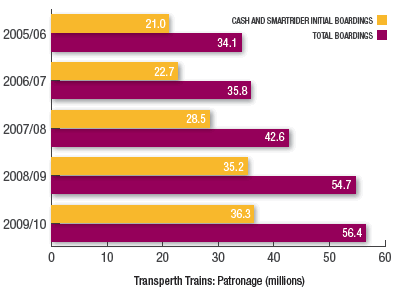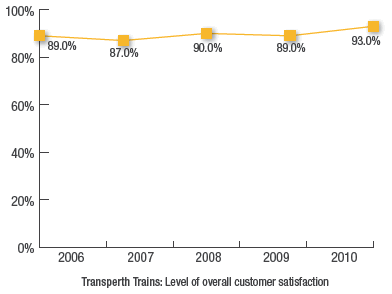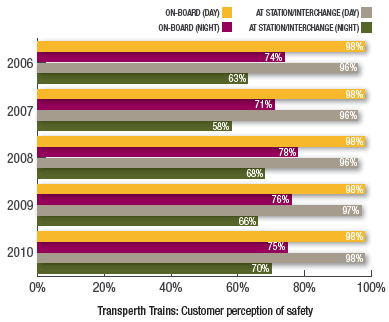Transperth trains
The TTO division operates an electrified suburban train system with more than 1045 services on an average weekday, and more than 6640 weekly services.
At June 30, 2010, the system covered 173.1km of track with 70 stations on five lines, and a fleet of 222 railcars which can be coupled in configurations of two, three, four or six-car trains. The train network consists of the Joondalup Line (33.2km), the Fremantle Line (19km), the Midland Line (16km), the Armadale/Thornlie Line (30.5km and a 3km spur line to Thornlie) and the Mandurah Line (71.4km).
The year’s developments
Work continued on the installation of the Platform Detection System on A-series railcars. This system promotes passenger safety as railcar doors will not open where there is no platform.
We took delivery of 24 new railcars (eight three-car sets) out of the 45 B-series railcars on order, bringing the number of new railcars delivered to 33 (11 three-car sets).
The Rostering and Payroll System (RAPS) was upgraded and implemented in the Transit Office area. This system improves staff rostering and payroll and has facilitated the decentralisation of driver rostering.
In 2009/10, the train network operated 13.582m service kilometres, down 6.5 per cent from 14.531m operated in 2008/09. This followed substantial increases in 2008/09 and 2007/08 and was due to the service revision introduced on June 28, 2009 to rationalise off-peak services.
Total capacity on the train network increased 14.4 per cent to 6456.2m in 2009/10 from 5641.3m in 2008/09 continuing the expansion which began in 2007/08 with the introduction of the Mandurah Line. The increase in 2009/10 occurred despite the reduction in service kilometres due to the increased use of three-car and six-car trains.
Cost of the service
In 2009/10, the total cost of providing Transperth train services, including annual capital charges, was $371.554m, up 2.2 per cent from $363.732m in 2008/09.
Train operating costs (i.e. excluding capital charges) increased by 2.3 per cent to $229.919m from $224.818m in 2008/09. The main factors contributing to this increase were the higher maintenance costs associated with the new B-series railcars, expenditure on modifications to the A-series railcars, increased public liability insurance premium, and improvements to the CCTV system.
Patronage
Patronage on Transperth train services increased for the sixth year in succession although the rate of increase was significantly lower than in the previous two years.
In 2009/10, cash and SmartRider initial boardings were 36.284m, up 3 per cent from 35.243m in 2008/09. Total boardings also increased 3 per cent, to 56.409m from 54.750m. Following the start of operations on the Mandurah Line, cash and SmartRider initial boardings increased 23.8 per cent in 2008/09 and 25.6 per cent in 2007/08, while total boardings rose 28.4 per cent and 19.2 per cent in the two years.
Fare-paying boardings on train remained high in 2009/10. The first full year of free travel for seniors, aged and disability pensioners had a relatively minor impact on train fare-paying boardings which fell by just 0.5 per cent to 34.642m compared with 34.815m in 2008/09. Comparing train fare-paying boardings on a like-for-like basis over the three-month period to June 30 shows a 5.9 per cent increase to 8.474m in 2010 from 8.0m in 2009.
Boardings per service kilometre on the train network recorded a significant improvement. While both cash and SmartRider initial boardings and total boardings increased, each by 3 per cent, train service kilometres fell 6.5 per cent to 13.582m from 14.531m in 2008/09, following the service revision introduced on June 28, 2009. Total boardings per service kilometre increased 10.2 per cent to 4.153 from 3.768 in 2008/09, while cash and SmartRider initial boardings per service kilometre also increased 10.2 per cent to 2.671 from 2.425.
An increasing number of train passengers are able to access the network though park ‘n’ ride facilities at train stations. At June 30, 2010, there were 16,963 parking bays across the system an increase of 6.3 per cent compared with 15,957 at June 30, 2009.
Passenger satisfaction
The 2010 Transperth PSM showed that the proportion of users who expressed overall satisfaction with the train system increased 4.5 per cent to 93 per cent of respondents from 89 per cent in 2009.
The importance rating of the key service characteristics of Transperth’s train services (other than passenger safety) and the level of satisfaction/dissatisfaction for each key service characteristic are shown in the table. Significantly, the satisfaction rating for all service characteristics except one either improved or remained unchanged.
| Service characteristic | Importance rating (%) | Satisfied (dissatisfied) (%) | ||
|---|---|---|---|---|
|
2009 |
2010 |
2009 |
2010 |
|
|
Cost of fares |
68 | 74 | 66 (7) | 67 (10) |
|
Cleanliness on board |
64 | 67 | 86 (5) | 88 (5) |
|
Speed of the trip |
60 | 67 | 93 (3) | 93 (3) |
|
Punctuality |
64 | 66 | 94 (2) | 94 (2) |
|
Availability of seats |
59 | 63 | 77 (17) | 78 (14) |
|
Service frequency weekdays |
49 | 58 | 85 (5) | 84 (6) |
|
Service frequency peak times |
49 | 51 | 81 (12) | 84 (7) |
|
SmartRider electronic ticketing |
42 | 37 | 93 (4) | 94 (2) |
Passenger safety
The 2010 PSM asked train users: “How safe do you generally feel from personal interference or threat from other passengers?”
The accompanying graph shows the proportion of respondents who “always” or “usually” feel safe at the specified times at the specified locations.
The results for the past five years show that the proportion of passengers who generally feel safe during the day has remained high. Also, there was a significant increase in the proportion of passengers who generally feel safe at night at the station/interchange (70 per cent, compared with 66 per cent in 2009) though there was a small reduction in the proportion of passengers who generally feel safe on-board at night to 75 per cent from 76 per cent in 2009.
The PTA is committed to ensuring that all passengers feel safe on our train network at all times. To help achieve this aim, digitised CCTV footage from all train stations is monitored at a state-of-the-art facility which is manned 24 hours a day, seven days a week.
Major initiatives for 2010/11
- Provide operational expertise for the Perth City Link project and the extension to the Joondalup Line.
- Continue to take delivery of and commission into service the new three-car trains.
- Continue the installation of the Platform Detection System into A-series railcars
- Continue recruitment of staff to service customer needs on the system.


